When the Germans invaded Belgium, Arthur Schrynemakers told his wife, who was French, and their three children, a son and two daughters, who were born in England, to flee to England. The son, also known as Arthur, joined the British Army. He dropped the name Schrynemakers and went by his middle name of Britton. He was first assigned to guard duty at Windsor Castle. He appears in the following photo on the left.
But when it became known that he spoke German, Dutch, and French as well as English, Arthur Britton was assigned to Field Security. His next assignment was to Tunisia, where he is shown in the photo below on his motorcycle in Tunisia. Note the 45 F.S.P. identification on the wall of the building.
Shortly after D-Day, Sgt. Britton and his men arrived in France. They were the first British troops in Lille and were mobbed by the happy Frenchmen, as you can see the photo below. He and his men were hoisted up and carried on the shoulders of the crowd to the best hotel.
Next stop was Brussels. There he was given a brief leave so that he could see his father, with whom he had had no contact for four and a half years. It was only then that Schrynemakers learned that his wife had died during the war. Britton is shown below with his father, Arthur Schrynemakers, and two other British soldiers in front of Schrynemakers’ home. The man on the far right has been identified as Arthur Alan Smith. Note the celebratory flags on the front of the buildings.
The following three photos were provided by Alec Bowman, nephew of Arthur Alan Smith. The first two show Britton, standing in the back row, with what presumably are other members of the 45th F.S.P. Britton is the one on the right in the back row of the first photo and with the big smile second from left in the back row of the second photo. He is on the left in the photo with the civilians. It is not known where the photos were taken. The first may have been back in England and the other two probably either in France or Belgium.
Arthur Alan Smith is (1) in the middle row with a moustache in the first photo, (2) holding his pipe at the far left of the front row of the second photo, and (3) on the far right of the photo with the civilians. Identification of Kenneth Baisbrown has been provided by his daughter, Stephanie Lopez (nee Baisbrown). In the first of the three photos, Mr. Baisbrown is on the left in the back row. In the second photo he is in the back row, third man to the right of Britton. In the third photo, he is in the front row, far left, with his arms crossed. Anyone recognizing any of the other people in the three photos is encouraged to share the information with us by contacting the webmaster.
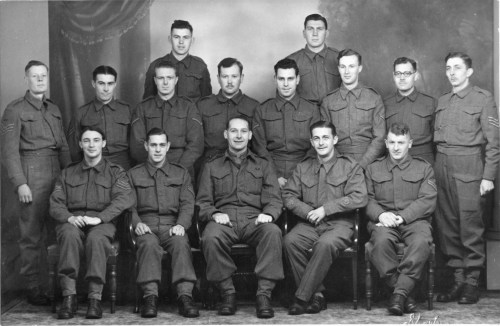

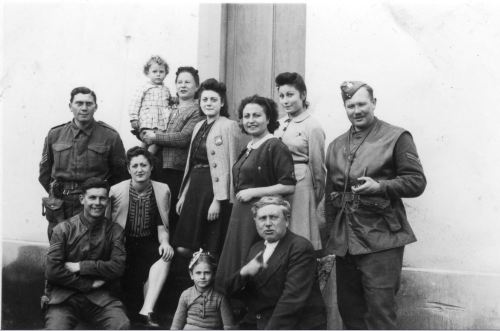
After Britton’s leave in Brussels came the Belgian Ardenne where he was responsible for checking the identity of American soldiers to make sure they were not Germans attempting to infiltrate the American lines. He is shown below at the far left in the Ardenne in December 1944. Thanks to the research of Jean-Marie Schrynemakers, the woman in the photo has been identified as Josephine Fivet, known as Fina, born in Yvoir, Belgium, Feb. 10, 1924.
On May 22, 1945 Britton and his men were manning a checkpoint at the Bremervorde bridge in west Germany. Three men were brought in for questioning by Britton, who examined their documents. One in particular, going by the name of Heinrich Hitzinger (misspelled in the arrest report as Hizinger), raised Britton’s suspicion. He arrested all three and turned them over to his superiors. (The following arrest report was provided to me by Britton and has been reproduced in several publications. Both reports appeared in Album Souvenir, 1942-1972, published by the Amicale des Milices Patriotiques du Front de l’Independance de Schaerbeek.)
Britton’s men added the following to the bare bones of the arrest report:
A very brief interview of Arthur Britton filmed by British Movietone is to be found at https://www.youtube.com/watch?v=RBfs_SYreIs on YouTube. A more detailed interview of Britton was done by Belgian RTBF television in September 2002. The title is “Le Coup de Filet d’ Arthur Britton Arrestation d’ Himmler,” and is in French. A copy with English language subtitles, posted September 4, 2018, is available on YouTube at: https://www.youtube.com/watch?v=uVZU-1Bv-6M&list=PLfO3-TNAQN-paJ3iZVjxoYVJtJ0yUlAQ_. In case of difficulty accessing the video with English subtitles on YouTube, try clicking here for a version of the video stored on DropBox. There is a momentary delay before the video begins playing.
During interrogation by the British officers, Hitzinger/Hizinger finally admitted to his identity: “I am Heinrich Himmler.” Shortly thereafter, he committed suicide, using a cyanide capsule hidden in his mouth.
After the liberation, Arthur Schrynemakers wrote to Tom Applewhite to bring him up to date with what had happened since Tom left. Regarding Himmler, he said: “You have read in the papers the end of the wanted criminal. Thus destiny would have it that the Boy caught the Biggest of the Bunch because this man had more to say than even Hitler.”
There are a good many accounts of Himmler’s arrest and demise. One particularly thorough article appeared as “Himmler’s Suicide” in the magazine After the Battle, issue no. 14, 1976. Another source, Nick van der Bijl’s new book, Sharing the Secret, The History of the Intelligence Corps 1940-2010, Pen and Sword, 2013, provides further information on Britton’s role (see pp. 166-167). Two newspaper accounts of Britton’s arrest of Himmler appear below. The first was published in the Flemish newspaper, Het Laatste Nieuws, 1946, with the English translation following.
From: Het Laatste Nieuws (The latest news) a Flemish newspaper in Brussels – 1946
The arrest of Heinrich Himmler
The executioner was a calm and modest man
The adventure of a sergeant in Bremervorde
Sergeant Britton Schrijnemakers, of Dutch descent and a member of the British Intelligence Service, came ashore in Algiers in 1943, took part in the campaign in Tunis, crossed over to Sicily, was recalled to England before the invasion and came ashore in Normandy on 9 June 1944.
As part of the major breakthrough to the north, he was with the 30th British Army when via Brussels he crossed the Albert Canal and took part in the rush of British tanks to Eindhoven and to the heavily fought for city of Nijmegen. While heavy fighting was going on at the Nijmegen Bridge, sergeant Britton, with his intelligent unit, occupied the NSDAP building on the Oranjesingel, where the roof shingles still rattled while exited Germans on the other side of the Waal in vain tried to make contact with their already departed Nijmegen unit.
After that came the massive breakthrough to the Reichwald, over the Rijn, Osnabruck, Bremen and finally to Bremervorde, the historical place where the executioner and hangman of occupied Europe, the head of the ten thousands of his brutes in the Sicherheitsdienst, whose terrible deeds could be seen all over the continent, was finally arrested himself, Heinrich Himmler, a Feldwebel, who a few days earlier had made an offer of peace.
THE ARREST
“It was five o’clock in the afternoon” related sergeant Britton “when a group of ten men crossed the bridge at Bremervorde where I was on duty. Three of them, two big blond fellows with a shorter older man in between them ………………(missing)……………………
British headquarters were he identified himself and a few days later committed suicide.
HIMMLER, A CALM AND MODEST MAN.
What impression did Himmler make on you? He was the calmest most modest man that I had ever met ………(missing)…………….
HE ARRESTED
Arthur Verdun Britton Schrijnemakers, son of a Dutch father and a French mother, himself an Englishman and now the representative of an American company in the Belgium capital, has, in a few days, become a famous person. He has been “discovered”, interviewed, photographed for newspapers and press services, he speaks on radio Lausanne and as soon as possible on radio Hilversum, and without conceit and with the air of youngster who finds it just fine, he has plastered the walls of his office with all the articles written about him, the man who on the evening of the 22nd of May 1945 arrested and brought in as prisoner Heinrich Himmler, Reichsfuhrer of the SS………..”
Another article appeared in the major Brussels newspaper, Le Soir, in 1970. An English language translation follows the scanned image of the article. My thanks to Jean-Marie Schrynemakers for providing the image. By a combination of clicking on the image and using whatever magnification feature your computer has, you should be able to make the article of a readable size.
British Ex-Sergeant tells us how he arrested Himmler on the
Bremervorde Bridge (L’ex-sergent Britton nous conte comment eil arrêta Himmler sur le pont de Bremervorde), Le Soir, Brussels, 23 May 1970, p. 5. (Translation by Mary Street, Nov. 25, 2008.)
On May 24, 25 years ago, Heinrich Himmler, the most powerful and
methodically cruelest accomplice to Hitler, committed suicide.
Himmler was one of the dominant figures in the demonic, irrational
and sinister world of the Third Reich.
It is certainly true that he remains one of the least known
characters in contemporary history.
While innumerable works by noted historians gave analysis and
described the life of Hitler, it is rare to find one that describes
and studies the personality of the S.S. Reichsfuhrer.
His crimes have been described, but hardly anyone has been able to
solve the enigma of his behavior.
People have analyzed the “Black Order” which he oversaw and the
concentration camp system that he organized, but no one can explain
his passion for evil, leaving us only to contemplate his vain, greedy,
meddlesome and cruel personality, to name a few of his vices.
Everything in his traditional family and his education leaves us also
to believe that Himmler would be devoted to a life free of misdeeds.
However, he became the monster of Nazi monsters.
In fact, Himmler was born in 1900, to a peaceful, comfortable family,
in which the laws of the Church were respected and in which they
enjoyed arts and music.
He himself chose the bucolic study of agriculture.
But this being, which everything had predisposed to a serene
existence living placidly on the land in the midst of nature and its
beauty, became paradoxically the incarnation of cruelty, terror and
death.
Even when he had attained the summit of malfeasance, every historian
similarly describes him as a being without awareness, without moral
and physical courage, without intellectual vigor.
All in all, he was like the evil that he incarnated, including the
most contemptible affectedness: incomprehensible, indescribable.
The peaceful farmer that Himmler was before becoming
Hitler’s aide appeared for the first time in Nazi history during the
aborted putsch on 9 November 1923.
On that day he was taken without glory and without resistance to the
police in Munich, leaving the building in which the attacking troops
of Rohm had barricaded themselves, carrying their flag.
Remaining loyal to Hitler during his years of imprisonment and of
unsuccessful political battles, Himmler gained the confidence of the
Fuhrer and became, in 1929, commandant of his personal guard, the S.S.
Henceforth his fate was sealed: systematic assassination, organized
on a colossal and inhuman scale, became his reason to live, and death
became his career.
Haunted by his ambition to create the elite Aryan as the basis of
Nazism , Himmler, who had no Aryan traits, created the “Black Order
S.S.” Himmler became through the immensity of his crimes the most
heartless person bereft [of] scruples that contemporary history has known.
Gestapo chief, grand master of the universe of concentration camps,
optimistic commissary of the Reich for occupied territories of Poland,
executor of the “final solution” which was supposed to end in the
extermination of more than 20 million Jews and untermenschen in all of Europe, exterminator of tens of millions of soviet prisoners of war,
executioner of the German resistance after the attempt on Hitler’s
life on 20 July 1944, Himmler was, for the Fuhrer, “der treue
Heinrich”, or loyal Heinrich.
Up until the day in April, 1945 when he made contact with Count
Bernadotte, president of the Swedish Red Cross, in hopes of saving his skin by cashing in on the lives of Jews in concentration camps and in proposing to the allies to arrive at a separate peace by joining with
him against the Russians.
Dismissed from his functions by Hitler, who lived his last hours in a
“bunker” in the chancellery in Berlin, Himmler prowled around in the
entourage of Admiral Doenitz until 5 May 1945.
Notwithstanding his crimes, he remained convinced that the fear that
he inspired in others would still make him second in command in the
new German state, and that he would thus be able to negotiate the
surrender of Germany while saving himself.
But Doenitz wanted none of it.
That left nothing for the Reichsfuhrer S.S. but to disappear
temporarily in the ruins of the millennial Reich in which he had been
the sinister sorcerer.
Although his name was at the top of the list of war criminals being
hunted by the allies, Himmler was narrow-minded, imagining to himself that at the moment of Nazi capitulation he could save his skin, thanks to the western allies.
He thus prepared himself to appear of good will by guaranteeing the
saving of concentration camp prisoners, and his proposals for a
separate peace to the Anglo-Americans, and his offer to put the
Wehrmacht at their disposition against the Russians, in order to
conquer together the communist threat, and, especially, the crushing
dossier he had created against Goebbels and Bormann in order to prove that they alone had been the inspiration behind Hitler’s criminal
politics.
The “Feldwebel” Hizinger
While waiting to make his final move, Himmler disguised himself,
under the false name of Heinrich Hizinger, an unknown Feldwebel,
carrying a demobilization certificate created on 3 May 1945 and
joining up with some Panzers who had returned home.
He shaved off his mustache, covered one eye with a black patch and
wore civilian clothing.
In this disguise, he was able to go about unnoticed in the flow of
disorderly German soldiers who wandered everywhere, fleeing the
Russians or returning to their families. The S.S. Reichsfuhrer,
accompanied by some loyalists, tried to leave northern Germany, a
region which was particularly inhospitable to him.
In fact, the allies were constantly on the lookout for him, knowing
that he might have been spotted a few days before while making contact with Count Bernadotte.
Thanks to his disguise and to his false papers, he hoped to climb over the Bavarian mountains in order to remain hidden until the day when troubles, which, in his estimation, would make havoc in the new Germany, just as after the armistice of 1918, would permit him to resurface, to reintroduce himself, and to negotiate with his conquerors.
Evidently, he had not understood that this time the allies were
determined to chasten the Germans responsible for war crimes, just as he underestimated the capabilities of the British security services as he traveled through the occupied zone.
On 22 May 1945, at 17:00 hours, three German civilians appeared at
the Bremervorde bridge, the only bridge left intact between Bremen and Hamburg.
The 1003 detachment of Montgomery’s Field Security Reserve Detachment was standing guard there.
Two days prior, 12 S.S. agents were sighted and arrested there. At
their interrogation, they confessed that two of their group had
remained at a farm in the area.
The British looked for them in vain, but the incident made them
increase their vigilance.
The papers of the old German military were, one must say, the object
of particular examination. The members of the Intelligence Corps had
learned, in England, to recognize the characteristics of each stamp in
use in the diverse German units, and they had received orders to
arrest on the spot anyone carrying the stamp of Entlassungschein in
the S.S. regiments.
A Revealing Stamp
Without any difficulty at all, the chief sergeant on guard at the
Bremervorde bridge [Arthur Britton] discovered under the stamp of the Wehrmacht affixed on the Schein of the Feldwebel Heinrich Hinziger a trace of an old stamp from the Geheime Feldpolizei. Also, he found it odd that the
lieutenant who accompanied the Feldwebel Hiziger presented himself
first, as officer of the senior echelon, instead of his non-
commissioned officer: not to mention that the latter appeared to be
neither a great captain or a hero.
Convinced that he had discovered enough to retain the three
civilians, Sergeant Britton put Hizinger and his two companions under
arrest as S.S. and sent them under heavy guard to higher authorities
for identification.
Interrogated separately at Post 031 at British Security near
Lunebourg by Captain Selvester, our three Germans got confused and
contradicted each other. The interrogator decided to confront them. At that moment, Hizinger took off his eye patch and declared himself the S.S. Reichsfuhrer Heinrich Himmler.
Stupefied, Captain Selvester had only one fear from that moment on:
that his prisoner would swallow a cyanide capsule, since he knew the
Nazis had been directed to carry them.
In order to know whether he could, without any danger, begin an
examination of Himmler’s jaw, the British officer calmly asked him if
he would like a sandwich and a cup of tea, before continuing with the
interrogation.
Himmler accepted, delighted: but Sylvester was more delighted at the
success of his strategy!
After that, all that remained was to have Himmler change his clothing
in order to spare him the “battledress” that he was
wearing. He declared that he did not want to be shot like a spy in a
British uniform.
Under threat of being transferred naked as a worm to “Monty’s”
quarters, he finally donned a shirt, shorts and socks, all made in
Great Britain.
The Cyanide Capsule Inserted in his Jaw
At the British general’s headquarters, Himmler was handed over to
Colonel Michael Murphy, chief of Security Service. The latter took him
to the Lunebourg prison, where a military doctor was prepared to give
him a thorough body search in order to locate the cyanide capsule that they had vainly looked for in Himmler’s clothing.
At the moment in which the doctor, Captain Wells, ordered him to open his mouth, Himmler chewed the poison encased in his jaw.
Despite the most energetic care possible, he died in twelve minutes.
Heinrich Himmler thus slipped away from his judges, but at the same
time he stole from history a great deal of secrets which will probably
never be discovered by historians.
Since Sergeant Major Austin was assigned to guard the illustrious
prisoner, he was a witness to the suicide along with Colonel Murphy
and the doctor. He was ordered to bury Himmler in the utmost secrecy.
No one will ever know where he is buried.
Thus, Himmler may remain forever the most enigmatic character of the Third Reich.
Mr. Britton: “Himmler, a person without prominence”
Following another preceding article which appeared in Le Soir, I had
the opportunity to meet with Mr. Britton, the British soldier who
arrested Himmler at the Bremervorde bridge on 22 May 1945.
I had the pleasure of making the acquaintance of a businessman who is dynamic, very friendly, smiling, and without vanity, and whose Belgian education at l’Institut Saint-Louis in Brussels as well as 43 years of living in Belgium have not erased his Britishness.
At the time of the German invasion, in May 1940, Mr. Britton was
eager to return to Great Britain to volunteer for the war.
Assigned to the Grenadiere Guards (that is to say that Mr. Britton is
no wimp!) he progressed quickly to the Intelligence Corps. In this
security service he served in Africa and the Tunisian campaign in 1942, as well as the landing in Sicily in 1943.
In June 1944, he participated in the landing in Europe and was with
Montgomery’s army in Normandy, Lille, Brussels, Nimegue, and the
Ardennes, reaching the Rhine in 1945.
Mr. Britton has received many impressive British military
distinctions . . . but you have to make him talk about them in order
to be aware of them.
Just as we had to do in order to get him to confide in us the
impressions that Himmler left with him.
The Reichsfuhrer remains, for him, an S.S. like the others, who had
to be “rolled over” (interrogated or searched?) when he appeared on
the bridge, hoping to pass by unnoticed with his eight day old beard,
his long hair, his phony wounded disguise, and his demobilzation
papers rubber stamped by the Wehrmacht.
Mr. Britton feels very simply that he was lucky to be more informed
than Himmler . . . and that’s all!
He finds that it was not for nothing that they had “drilled” at the
Intelligence Corps before beginning the pursuit of the S.S., that he
was taught to recognize the Wehrmacht stamps . . . and others, and
that they had familiarized him with the arrogant behavior that German officers generally had toward their inferiors.
Also, Mr. Britton thinks that they benefited from those naive S.S.
who had told them that they had left two of their comrades at a farm
in the area.
From that day forward, the head guard at the Bremervorde bridge
redoubled their efforts, keeping their eyes open so that nothing was
allowed to pass by them unnoticed.
After that, there was a ceaseless effort to uncover the two escapees.
That they would appear at his bridge with a third man would not help
them . . . at Bremervorde everyone was on the lookout!
As I asked Mr. Britton why he kept a precise memory of Himmler, he
answered that it was certainly not because of his exterior personality.
Himmler the man had nothing about him to draw attention.
“. . . He looked like a vanquished German, just like all the others.
Of medium stature, he made no impression. Neither his appearance nor his way of expressing himself would lead you to guess that you were face to face with the most sinister and cruel potentate of the S.S. Also he did not appear to be a leader of men or a chief. He did not look like a great man . . . not even a gentleman. During the interrogation, he presented himself flat as a fig. He
remained guarded, his heels together, obsequious like any other pale
“Fritz” who is innocent of Nazi crimes. He looked like a man without a
past! . . .”
If however Mr. Britton remembers Himmler, it’s because of his eye
patch, no doubt, because it evoked pity for a wound. Then it was
because of the blunder made by the overly zealous lieutenant: it was,
finally, because of the counterfeit rubber stamp of the Wehrmacht.
Also he did not hesitate an instant to inscribe on the arrest
mandate: S. D. (Sicherheidsdienst: S.S. security service).
A Memory: the Gestapo Chief’s Slippers
Naturally Sergeant Britton was informed immediately of Himmler’s
identity and of the importance of his successful arrest.
Confident in his abilities, his superiors sent him to the farm where
Himmler had hidden in order to find his baggage.
He found only one suitcase containing underwear and a manicure set
made of gold, engraved with the initials R.F.H.H. (Reischsfuhrer
Heinrich Himmler).
Always the gentleman, he returned the valise intact to the
Intelligence Corps.
But his superiors had the sense of humor to give him Himmler’s
sllippers. So for one day, the improbable happened and Britton became an old duffer padding about in his slippers.
Today, Sergeant Britton, now Mr. Britton, is a businessman like any
other. Visibly, Himmler does not haunt his memory.
When he thinks about it, it is to regret most of all that the
Intelligence Corps could not deliver him to his trial.
But that is another story.
I tried to evoke memories or impressions from Mr. Britton in order to
show publicly an homage to his perspicacity, to be sure, but also
because this witness who had no idea who he was arresting when he
arrested Himmler, confirms what historians generally tell us about the
pale and inoffensive person who was truly the most sinister of the
Nazi notables.
This is not the least of paradoxes in the life of the monster of
monsters who left to history the halo of a colorless being, though
full of mystery, after having been the man who exercised the most
colossal power ever seen in crime.
Thus Himmler, whose career was death every day, will appear to future generations as mysterious as the hideous Nazi death that he created, mysterious and enigmatic, for all time, in all of Europe, enslaved in his bloody yoke.
Maurice Herman
Captions:
Himmler photographed during a visit to the Low Countries, early 1944.
Less than 15 months later he committed suicide at British headquarters
near the Bremervorde bridge.
Sergeant Britton, 25 years ago, around the time of Himmler’s arrest.
Mr. Britton, in his Brussels garden today, near the Soignes forest.
in the box:
The Gestapo chief, posing as a demobilised soldier, wearing civilian
clothing, an eye patch, tried to get to Bavaria to hide out. [End of article.]
Arthur Britton
PATHÉ NEWSREELS OF HIMMLER’S DEMISE


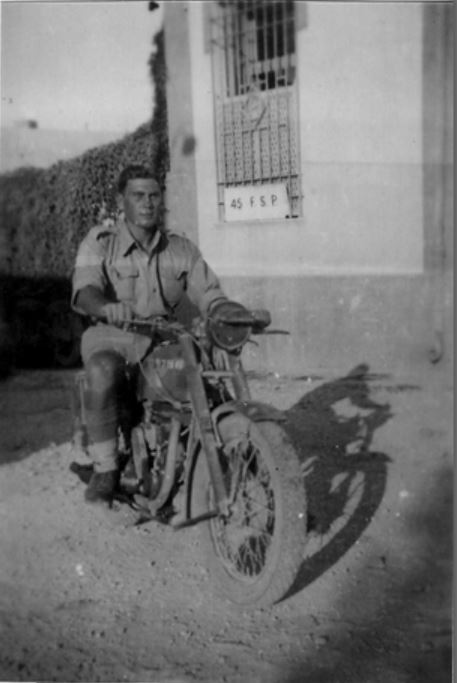
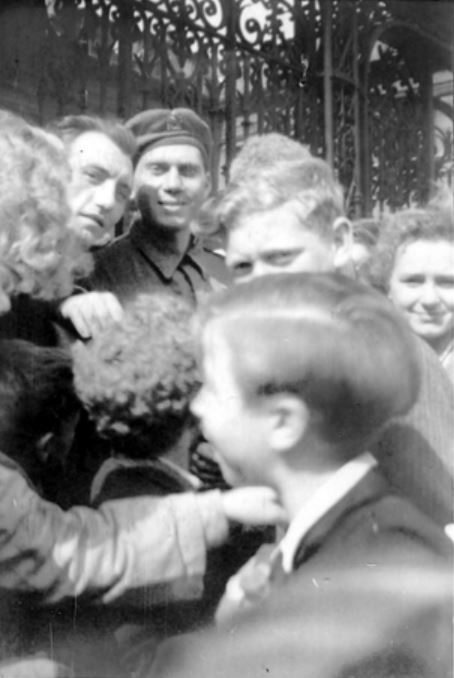

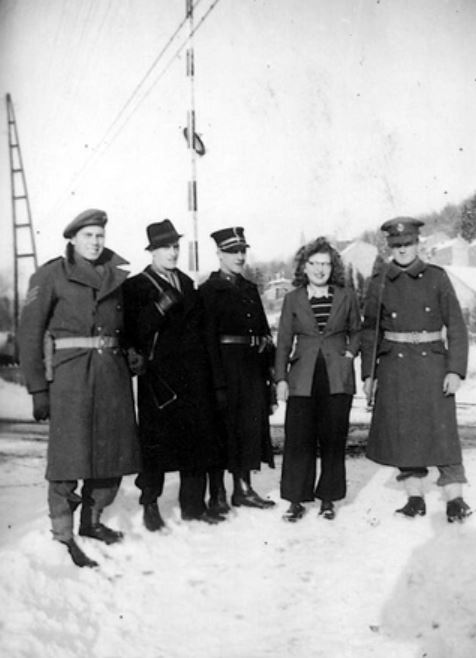




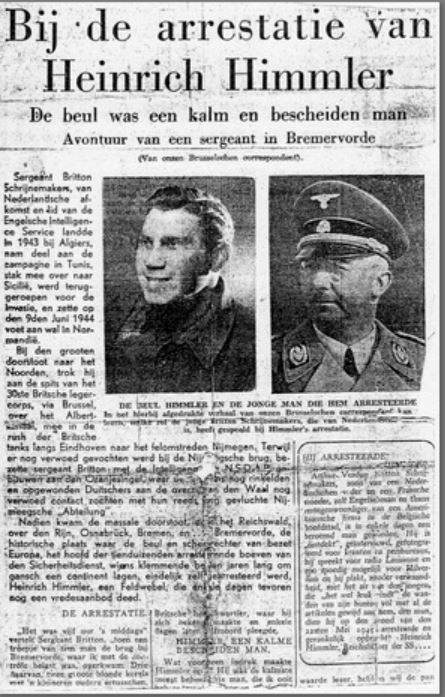


Regarding the photo outside Schrynemakers’ home featuring four men, Arthur Britton, his father and two unknown soldiers; the soldier on the far right is my uncle Arthur Alan Smith (his is the first signature on the second page of the arrest report for Heinrich Hizinger, alias Himmler).
Good morning, I’m working on a book about Himmler’s death. I would like to contact the family of soldiers who arrested him as Heinuch Hitzinger. (The webmaster has put Mr. Drozdowski in touch with two members of the family of Arthur Britton.)
My Uncle is Grenville (Gren) Grayer, also a signature on the arresting letter (far right in the bolder pen). Gren passed away 20+ years ago but he told us of the story of his participation of Himmler’s arrest on the bridge and that he was one of the intelligence NCO’s who also went to the Barn at the farmhouse where the belongings were found. Fascinatingly Gren (somewhat of a “collector”) acquired Himmler’s silk lined toilet bag, which we still have. Gren told us of the way Himmlers belongings were checked and the bag was clearly investigated for cyanide as the lining is slashed. There are a number of papers that he also left and will recover these from storage and check these out. We have photos og Gren and would be most happy for an image to be published on this fascinating web site as he would obviously have known Arthur Britton and Alec Bowman, if you felt it appropriate
Dear Chris
I am collating an account of Himmler’s capture and would welcome any information that you have of your uncle’s involvement. Copies of documents and photos.
Regards
Nick
Hello, excuse my school English.
I wanted to ask you a question :
What contained Himmler’s bag hidden in the barn?
Thank you
Greetings from Italy
Hello,
In his YouTube interview, “The Arrest of Heinrich Himmler”, which is in French (see https://www.youtube.com/watch?v=6-C6I5_Gj_g&index=18&list=PLfO3-TNAQN-paJ3iZVjxoYVJtJ0yUlAQ_), Britton says that there was a small valise hidden at the farm house and that it contained a shirt, pajamas, bedroom slippers, and a toiletry case with an insignia that read “Reichsfuhrer SS”. Britton kept the slippers.
Best wishes,
Bruce Bolinger, Webmaster
I am former Intelligence Corps and am a trustee of the Military Intelligence Museum. We would be very interested in anything related to the capture of Himmler – photos and artefacts etc. The Int Corps were heavily involved in arresting alleged German, Italian and Japanese war criminals. Another in Germany was Rudolf Hoess, the Auschwitz commandant. A RAF pilot named Winkler Brown claims he interrogated Himmler. Is this correct?
I am conducting a research project on Heinrich Himmler and I’m citing this article as a source. Could you please give me the name of the person who wrote this article?
Reply:
The article was written by Bruce Bolinger, who is the webmaster for the website as well as a cousin of Arthur Britton. Bolinger’s grandfather, Theodore, and Britton’s father, Arthur, were brothers. Bolinger met with Britton several times and corresponded with him extensively. Britton shared documents and photos with Bolinger.
Webmaster
Nick, Please can you send me your email address. I lost all in a computer crash some months ago
Chris Grayer
Dear Chris
Delighted to hear from you as I am putting together an article for the October edition of Britain at War – at their request. I cannot find our email exchange and I wanted to include your father’s role.
Regards
Nick
Chris
As requested
Good morning, I’m working on a book about Himmler’s death. I would like to contact the family of soldiers who arrested him as Heinuch Hitzinger.
Dear Mr. Drozdowski,
My apologies for the long delay in replying to your comment. I asked Arthur Britton’s daughter but she felt she had no information that would be helpful to you. I recall that several years ago I corresponded with a gentleman who was a volunteer at the Imperial War Museum in London and who said a family member of his was one of the British soldiers who detained Himmler and his two aides and brought them in to Britton for interrogation. Unfortunately, I am unable to find my correspondence with him and cannot recall his name. Possibly the IWM could put you in touch with him.
Best wishes,
Bruce Bolinger
The false identity document used by Himmler, and recognised By Sergeant Arthur Britton as being suspicious, and leading to Himmler’s arrest, has now been donated to the Military Intelligence Museum in the UK. The full story is on the museum website at https://www.militaryintelligencemuseum.org/himmler-identity
Is there DNA evidence to prove that it was Himmler who had committed suicide on that May day?
It seems highly unlikely that there is. Use of DNA is a relatively recent development. For example, from what I found on the Internet, DNA evidence was first used in a criminal case in England in 1986. Any possessions Himmler had at the time of his arrest, if they still exist, probably have been handled by so many persons since then that extracting a reliable specimen of his DNA would seem to be very difficult. Another source might be his family but they might have no interest in participating.
My father, James(Jim) Rimmer, was a sargeant in FSS 45 and is a signatory on the particulars of arrest. He remained in touch with some of his unit and in particular Grenville Grayer who was known to us as Gee. My father does not appear on any of the photos. I am unable to add anything further to the accounts of Himmler’s arrest. My father died in 1991.
I have just spotted my father Jim Rimmer on the middle photo of three below the formal photo. He is on the front row wearing glasses to the immediate right of Grenville Grayer who is smoking a pipe
only to say that the ‘misspelling’ Hizinger was on this German document (the one Britton saw?) …. I’ve just been watching Mark Felton’s programme see 19 minutes 7 seconds. https://www.youtube.com/watch?v=MyWspZnxagA.